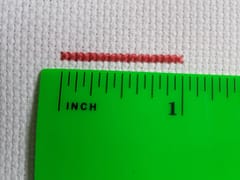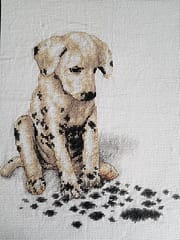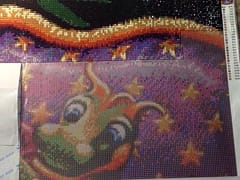Review of CXC Branded Floss
Less expensive than DMC, is it worth the money?
Contents
- Introduction
- Price Comparison per Skein
- Color Comparison
- Coverage Comparison
- Thread Handling
- Colorfastness
- Lightfast
- Environmental Concerns
- How to Order
- Conclusion
Introduction
Although the image of cross-stitching may be one of “home needlework” and thrift, it can quickly become an expensive hobby (especially for us “serial starters”) so it is always good to discover another way to make your crafting budget go a little further. DMC is an established company that has quality product and it has also over time become standard in the market with regards to chart designers and kits - pretty much every pattern uses the codes and colors that they define. However it is becoming more and more pricey kitting up a large full-coverage chart, especially if you are in Europe or Australia and many people are not aware that there are other options out there. One increasingly popular option is CXC branded floss that is made in China.
There seems to be a lot of curiosity along with no small amount of scaremongering and misinformation on Facebook groups regarding CXC and other cheaper brands, coincidentally though this often seems to originate from groups associated with stores that sell DMC based kits ! hmmm. However, the people who actually just stitch really seem to love CXC and highly recommend it, so when you hear someone claiming it is not a quality thread, not color-fast or any other “reason” make sure you are aware of their possible motivations. This is a common tactic within the IT industry to spread “FUD” about competitors to put people off using them - fear, uncertainty and doubt, stick with what you know … keep paying us.
But let me be clear, this article is in no way meant to discourage people from using DMC, at the end of the day it is all personal choice and many people will prefer to stick with a tried trusted company such as DMC or Anchor and they are very accessible with distribution channels through many large-name and local stores but it is always good to consider your options and have the extra information especially when on a budget or kitting up a large project. After all, few of us can really ignore what could be a difference of $20 vs $220 to purchase the floss alone for a single project!
Here I am going to do a comparison of a few brands and a review of my first experience stitching with CXC compared to DMC and I will also document washing a sample show that they are indeed also color-fast
CXC is a soft poly-cotton mix/blend - it is noticeably thicker and softer to handle than DMC. The CXC uses the same numbering convention as DMC but will sometimes only have one large label with the number on which looks very similar to a DMC number label. In other batches you may find the CXC skein with two labels this is the exact same thread. I’ve been told the two label skeins are from newer batches.
Here are some close up photos of the labels to help identify the brands
CXC Skein one label
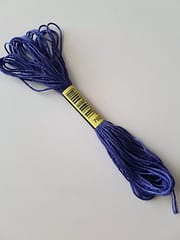
CXC Skein two labels
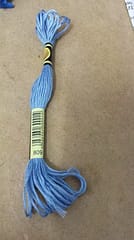
Picture credit Cindi Cscraze
No-name generic brand (that typically comes in multi-packs if you don’t specify CXC)

DMC Skien
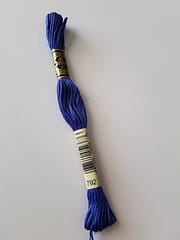
Note that DMC also includes a dye-lot code as well as the main thread code (792 above). If you are bothered about buying a fully matching set of skeins you should consider checking those when purchasing.
Price Comparison per Skein
So how do the prices compare? The following are all in USD:
- CXC - $0.08
- No-name generic - usually comes in a “random pack” that has various brands included $0.08
- Royal - $0.20
- Rosace - $0.38
- DMC - $0.52 123 Stitch - $0.73 DMC website
The difference between buying a full set of 489 DMC skeins is $255 USD on DMC’s website vs approx $36 USD for a full set of 447 CXC from AliExpress sellers. CXC don’t yet have the 35 new DMC colors (but then neither do most stores at the time of writing!). DMC also seem slightly confused about how many colors they actually sell - we’ll write about that in a future article.
The great thing about these brands is it is not huge risk or investment to try them out. You could start with a small batch for around $5 - $10 and go from there.
Color Comparison
Left DMC, middle CXC, right No-name generic
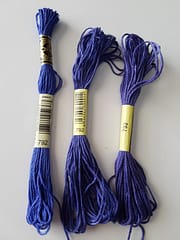
With this particular color I can see a slight variance between the DMC and the other brands but I don’t think it is that significant and as long as you didn’t change brands in the middle of a solid block of color it wouldn’t make much difference at all. The DMC color is brighter / more saturated whereas the others are more purplish by comparison (but check the coverage images below - the difference becomes less noticeable). Also, as you’ll see with other images below, you can see this same variation even between different dye-lots of DMC color.
Left is CXC (with two labels), middle is Rosace, right is DMC
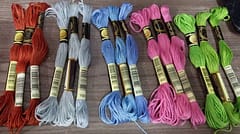
Picture credit Cindi Cscraze
As you can see from the photo above CXC and DMC look pretty much identical, the Rosace in the middle is ever-so-slightly different but hardly noticeable - probably the kind of variance that you could see anyway between dye batches of DMC, see picture below (and also the differences between the palettes of many cross-stitch charting applications). Again as long as you didn’t switch brands in the middle of a solid block of color this wouldn’t really matter. One thing I have seen mentioned about the Rosace thread though is that it tends to fray more than CXC and DMC.
DMC skeins with color variance between dye lots

Picture credit Cindi Cscraze
Ultimately, we’re talking about very slight variations between the brands but there are many other differences such as the palette that apps use to generate patterns and how colors are matched. The threads fall well within the range of what you’d expect for the codes.
Coverage Comparison
I currently have CXC, the no-name generic that comes in the mix brand pack and DMC for the comparison but I hope to add to this later with other samples. I decided to use 16 count for the samples as coverage is can be more of an issue on the lower counts of fabric.
After completing the samples below it is clear that both CXC and the no-name generic brand actually give better coverage than DMC. I actually only stitched up-to 3 strands as it was so much thicker to use than the DMC, it is almost like you are using an extra strand. This alone can make it cheaper still as your thread will last longer if you are not using as many strands together when stitching.
DMC, CXC, no-name generic
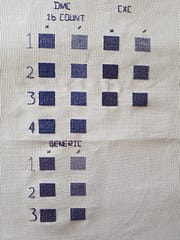
One thing to note is that when the samples are stitched the slight color variance is much less noticeable
Close-up, DMC, CXC, Generic no-name brand
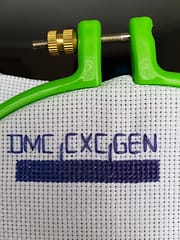
Close up DMC
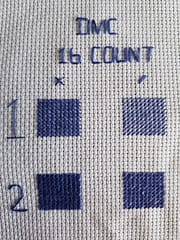
Close up CXC
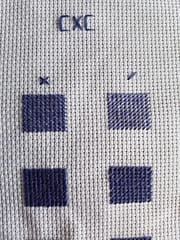
Close up No-name generic
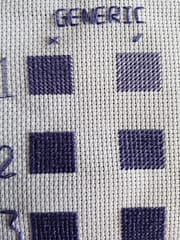
Holding sample upto light highlights the coverage, especially for 2 and 3 strands. Yes messy back and I carried my threads and there are long tails :-)
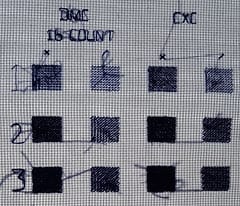

The half stitch especially highlights that the coverage is better with CXC compared to DMC - there is much less light showing through the stitched areas
Here is another stitched sample provided by Erica Terry
DMC on the left, CXC on the right
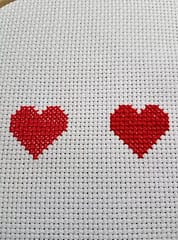
Picture credit - Erica Terry
As you can see from the image above the CXC on the right is much thicker and provides better coverage than the DMC on the left, there is much less white fabric showing through. This particular color looks identical to me
Here are some examples of works in progress projects using CXC, DMC and Royal
Mix of DMC & CMX - 80% DMC, 20% CXC
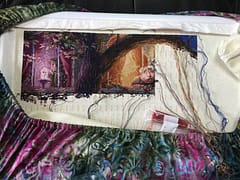
Pure CXC
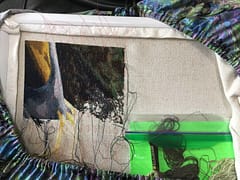
Pure Royal

Thread Handling
Stitching with CXC is very nice, it doesn’t tangle or twist much while stitching, although some stitcher prefer to use slightly shorter lengths with CXC to prevent thinning towards the end. It is very soft and smooth to handle. It actually slides through the Aida very nicely and I would say it is actually smoother to handle than DMC. The individual strands separate from the group of 6 very easily and didn’t tangle or snag.
The one issue that I had was that is did not come off the skein as easy as DMC does, it tended to bunch up when I pulled from the end, but thanks to the helpful stitchers on Cross Stitch Unlimited I’ve learnt that the trick is to pull from the other end that is often buried inside under the label not the long tail that is obvious like DMC.
Colorfastness
There is not much to say except - these threads ARE colorfast. Here is a sequence of photos showing me washing the sample (I even used slightly warmer water than normal, with Dawn dish soap)
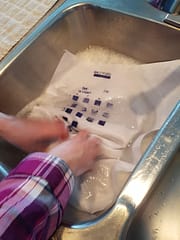
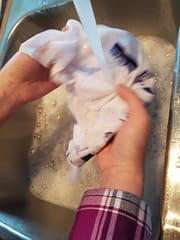
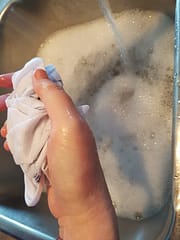
Washed - tails showing through the wet translucent fabric from the back
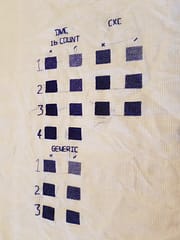
Paper towel laid onto wet sample

Towel - no color seepage
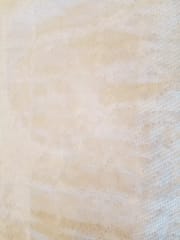
Pressing down hard on swatch area
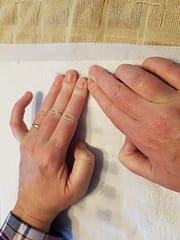
Back of Towel
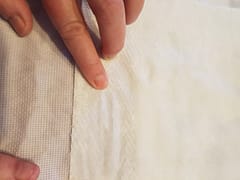
After washing and drying (a little crinkly)
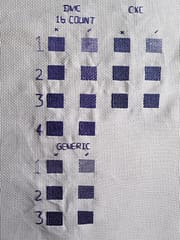
Close up after wash
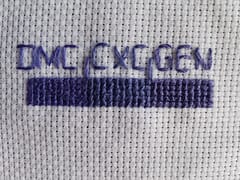
I also left an bundle of papertowel pressed down on the stitching and went out for two hours, came back and there was no color on the towel
Lightfast
Another charge leveled at the cheaper branded floss seems to be that it will fade over time but this can be said of any brand of floss including DMC. Proper finishing of a piece is very important along with deciding where to display it - any stitching hung in direct sunlight will fade over time no matter what brand of floss you use.
Also Polyester tends to retain color better than cotton which is part of the reason it’s used in clothing, CXC is a poly cotton mix so will likely fade less than DMC which is 100% cotton.
Environmental Concerns
CXC is manufactured by the ZheJiang QuingChun Thread Industry. According to a number of website directory listings all the products adopt the environmental-protection dye and auxiliaries. The quality of the products have reached and exceeded the FZ/T63002-93 standard. In addition the corporation has passed the voluntary ISO9001:2000 International Quality System Certification by CQC. The CQC Mark guarantees conformity of the product with Chinese Guobiao standards regarding safety, quality, environmental and energy efficiencies. Products marked with the CQC Mark are less likely to be detained at Chinese customs.
One thing to note is the CXC is by no means a new product and has been used for many years, so the charge often leveled that you will be poisoned by licking the thread etc is kind of ridiculous and just more fear tactics.
How to Order
The ordering process for these threads from AliExpress can initially seem quite intimidating and involved, especially if you want to specify particular colors, but from listening to others’ experiences it really doesn’t seem that bad once you try it - it’s similar to eBay there are just a few extra steps. Delivery can take a while as shipping is from China but it is often free or very cheap so if you are happy to wait a few weeks it may be a good option (and worth making a bulk order). It is also possible to order these brands through Amazon but I don’t believe you can specify colors with the Amazon multi-packs.
For more detailed information on exactly how to order CXC and other brands my suggestion would be to join and check out the pinned post in the Cross Stitch Unlimited facebook group - this is a very friendly group with a lot of information and no judgement. One of the motivations for the group getting stated was that many other groups were censoring anyone who mentioned or asked about CXC or even shared a WIP image that was stitched with it! It’s a hobby - we don’t need the stitch police to tell us that we should be spending more!
I am planning on ordering a complete set of CXC soon so when I’ve gone through it I will update this article with my experience of the process! Nicolette, the admin of the above Facebook group, kindly sent me the samples that I used for this article.
Conclusion
Cross-Stitching doesn’t need to cost as much as it sometimes does. Thread supplies make up a significant portion of the cost of the hobby but there are less-expensive options available. DMC make great thread and if you are happy with them and are fine with the prices then there is nothing wrong with continuing to use them. If you are looking for a less expensive option though it’s worth considering CXC and you shouldn’t let other people bully you into believing that they are substandard just because they come from China (where do people think iPhones come from?!) or that you somehow owe someone else a living buy only purchasing their much more expensive options.
Note: Since originally publishing this article there has been alot of interest in it along with no small amount of controversy including charges of my being completely biased as I am apparently “a HUGE CXC fan”. For the record, when I stitch I currently use 100% DMC floss as I have a large collection already built up. The grand total of my stash of CXC is 2 skeins which were sent to me to allow me to write this article! However in future I would definitely consider and recommend using CXC if I was to begin another large scale project.
Update: Checkout Lord Libidan’s review of cheaper threads for more tests and comparisons between DMC and CXC plus some other Chinese manufactured threads.
I hope you found this interesting and informative. As always, please like and follow us on our Thread-Bare Stitching Facebook Page or Thread-Bare Stitching Pinterest Channel for news and notification of future articles. Also checkout our Thread-Bare Flosstube Channel


